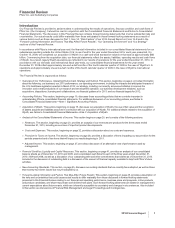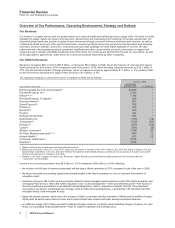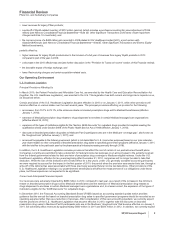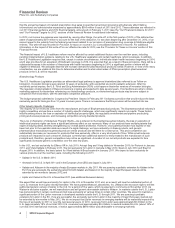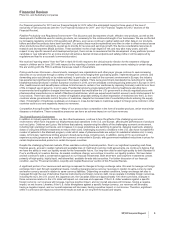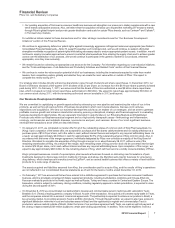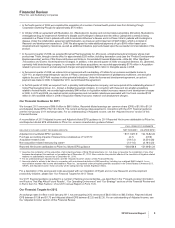Pfizer 2010 Annual Report Download - page 5
Download and view the complete annual report
Please find page 5 of the 2010 Pfizer annual report below. You can navigate through the pages in the report by either clicking on the pages listed below, or by using the keyword search tool below to find specific information within the annual report.
Financial Review
Pfizer Inc. and Subsidiary Companies
•lower revenues for legacy Pfizer products;
•a write-off of Wyeth-related inventory of $212 million (pre-tax) (which includes a purchase accounting fair value adjustment of $104
million) (see Notes to Consolidated Financial Statements—Note 3B. Other Significant Transactions and Events: Asset Impairment
Charges and Note 10. Inventories); and
•the non-recurrence of a $482 million gain recorded in 2009 related to ViiV Healthcare Limited (ViiV), a joint venture with
GlaxoSmithKline plc (see Notes to Consolidated Financial Statements––Note3E. Other Significant Transactions and Events: Equity-
Method Investments),
partially offset by:
•higher revenues for legacy Wyeth products due to the inclusion of a full year of revenues from legacy Wyeth products in 2010
compared to part of the year in 2009;
•a decrease in the 2010 effective tax rate (see further discussion in the “Provision for Taxes on Income” section of this Financial review);
•the favorable impact of foreign exchange; and
•lower Restructuring charges and certain acquisition-related costs.
Our Operating Environment
U.S. Healthcare Legislation
Principal Provisions Affecting Us
In March 2010, the Patient Protection and Affordable Care Act, as amended by the Health Care and Education Reconciliation Act
(together, the U.S. Healthcare Legislation), was enacted in the U.S. This legislation has both current and longer-term impacts on us,
as discussed below.
Certain provisions of the U.S. Healthcare Legislation became effective in 2010 or on January 1, 2011, while other provisions will
become effective on various dates over the next several years. The principal provisions affecting us provide for the following:
•an increase, from 15.1% to 23.1%, in the minimum rebate on branded prescription drugs sold to Medicaid beneficiaries (effective
January 1, 2010);
•extension of Medicaid prescription drug rebates to drugs dispensed to enrollees in certain Medicaid managed care organizations
(effective March 23, 2010);
•expansion of the types of institutions eligible for the “Section 340B discounts” for outpatient drugs provided to hospitals meeting the
qualification criteria under Section 340B of the Public Health Service Act of 1944 (effective January 1, 2010);
•discounts on branded prescription drug sales to Medicare Part D participants who are in the Medicare “coverage gap,” also known as
the “doughnut hole” (effective January 1, 2011); and
•an annual fee payable to the federal government (which is not deductible for U.S. income tax purposes) based on our prior-calendar-
year share relative to other companies of branded prescription drug sales to specified government programs (effective January 1, 2011,
with the total fee to be paid each year by the pharmaceutical industry increasing annually through 2018).
In addition, the U.S. Healthcare Legislation includes provisions that affect the cost of certain of our postretirement benefit plans.
Companies currently are permitted to take a deduction for federal income tax purposes in an amount equal to the subsidy received
from the federal government related to their provision of prescription drug coverage to Medicare-eligible retirees. Under the U.S.
Healthcare Legislation, effective for tax years beginning after December 31, 2012, companies will no longer be able to take that
deduction. While the loss of this deduction will not take effect for a few years, under U.S. generally accepted accounting principles,
we were required to account for the impact in the first quarter of 2010, the period when the provision was enacted into law, through a
write-off of the deferred tax asset associated with those previously expected future income tax deductions. Other provisions of the
U.S. Healthcare Legislation relating to our postretirement benefit plans will affect the measurement of our obligations under those
plans, but those impacts are not expected to be significant.
Current and Anticipated Financial Impacts
Our revenues were adversely impacted by $289 million in 2010, compared to last year, as a result of the increase in the minimum
rebate on branded prescription drugs sold to Medicaid beneficiaries and the extension of Medicaid prescription drug rebates to
drugs dispensed to enrollees in certain Medicaid managed care organizations and, to a lesser extent, the expansion of the types of
institutions eligible for the “340B discounts” for outpatient drugs.
In December 2010, the Financial Accounting Standards Board (FASB) issued an accounting standard update which provides
guidance that the annual fee based on branded prescription drug sales to specified government programs should be recorded as an
operating expense rather than as a reduction of revenues. After consideration of this new accounting standard, we currently expect
that the provisions of the U.S. Healthcare Legislation that became effective in 2010, together with the discounts on branded
prescription drug sales to Medicare Part D participants who are in the Medicare “doughnut hole” that became effective on January 1,
2011, will adversely affect revenues by approximately $600 million in 2011 and $500 million in 2012. In addition, we currently expect
2010 Financial Report 3



